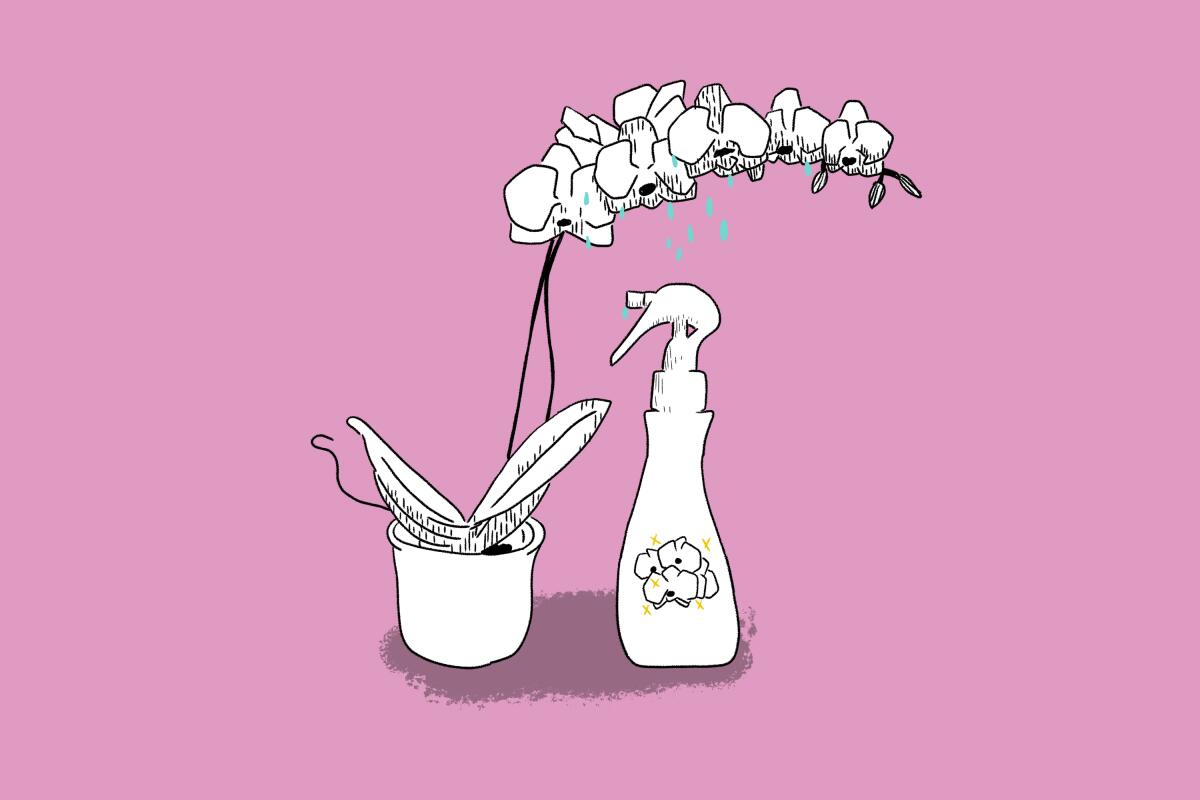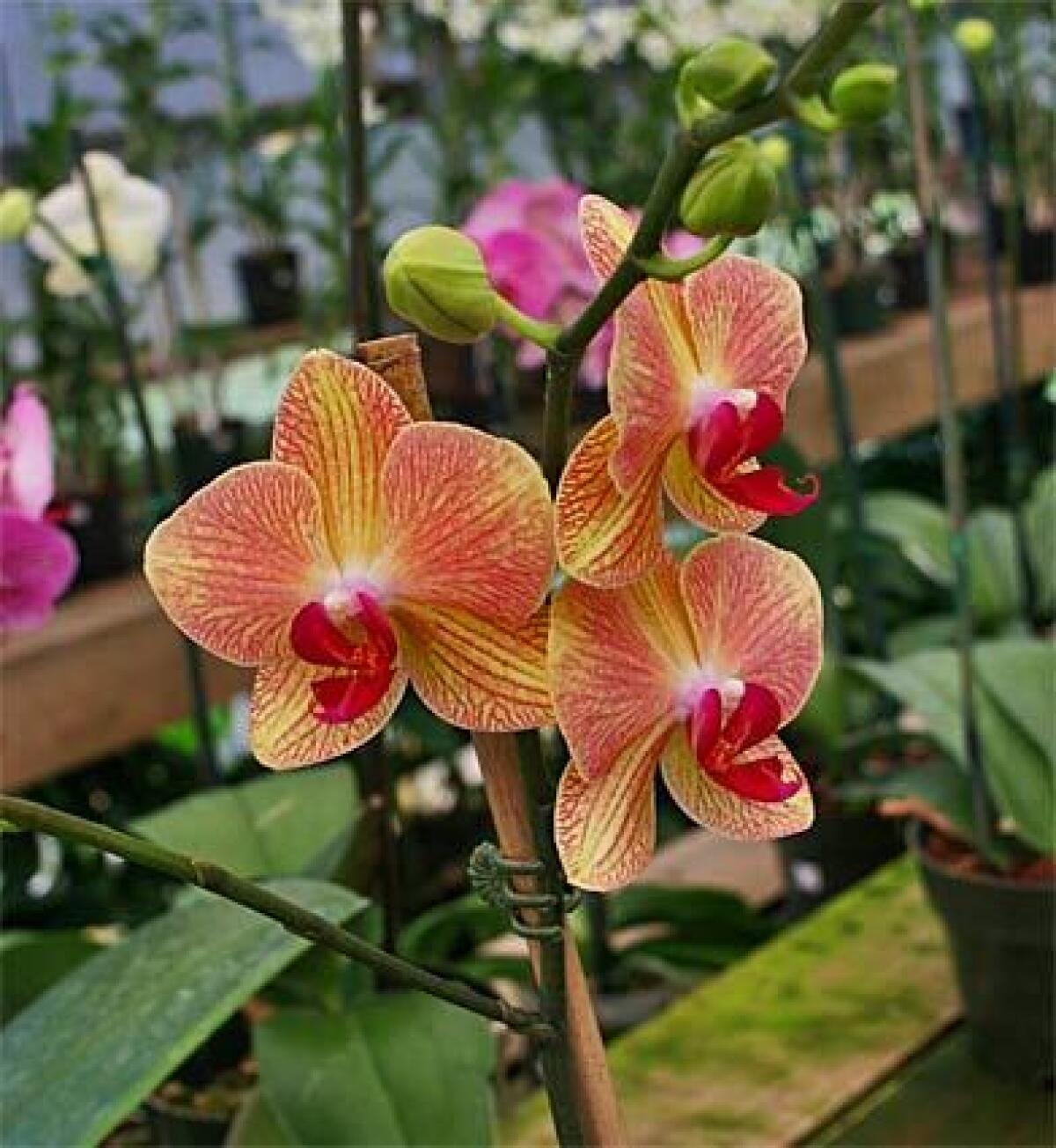How to keep Trader Joe’s orchids alive and other tips from the Huntington’s expert

As one of the largest plant families in the botanical kingdom, orchids fascinate orchid specialists like the Huntington’s Brandon Tam because of their sweeping diversity. “You will never find two alike,” says Tam, who oversees more than 10,000 orchids at the botanical garden in San Marino. “There are more than 20,000 species with around 70 different species in California. You can find them on every continent except Antarctica.”
You can also find them at your neighborhood grocery store, which makes them an accessible and affordable option for home hobbyists looking for an outlet during the pandemic.
They can be tricky. “People think the plant will rebloom multiple times a year, but the vast majority do not,” Tam says. “The flowers only last a month or two and will then rebloom the following year.”
Thirsty? Lack of light? Need to get rid of gnats? Here are the answers to the most frequently asked questions about houseplants.
At the Huntington, Tam oversees many rare and endangered orchids but appreciates grocery store varieties. “I’m glad orchids are available at Trader Joe’s and Home Depot because it gives people an introduction to orchids,” he says. “They can try these plants at home. I’ve killed plants too. It’s the only way to learn.”
Here, Tam offers tips on cultivating orchids you might find at your neighborhood grocery store.
What are the most common mistakes people make growing orchids?
The No. 1 reason people kill their orchids is that they overwater them.
In the wild, 70% of orchids grow on trees, limbs and branches. When they are attached, they don’t have moss or bark or anything excessive in the rhizome of the plant and will only retain enough to stay moist in between the rainfall.
If you buy a plant at Trader Joe’s, it’s sitting in 6 inches of moss. So if people are watering every three days, or twice a week, that’s too much. If I buy an orchid at Trader Joe’s, I water it once every two weeks if it has sphagnum moss.
There are two potting mediums: orchid bark and sphagnum. Orchid bark does not retain moisture between the bark particles. The sphagnum moss is so saturated, there’s no standard way to measure. In between waterings, these mediums need to dry out. If it’s sphagnum moss, I would recommend that you stick your finger in there to get an indication of how moist it is. It should feel fairly moist, but not saturated. Orchids need aeration for the roots to breathe.
What is the ideal spot for an orchid?
Most orchids don’t like direct sunlight. Place the plant in an east-facing window so it gets some morning light. People have this idea that if they put it right next to a window it’s protected, but it can get really hot. One hot session will set the plant back significantly.
Want to turn your living room into a jungle? These hanging plants are a good place to start.
Why won’t my orchid rebloom?
Inconsistency and not enough light. Plants need light to photosynthesize. People put them in offices without light expecting them to come back in full health. I would never recommend putting an orchid in an office that doesn’t have a window.
Plants hate unpredictability. In the wild, the rainfall and sunlight are predictable and they know what to expect. But when you throw inconsistent variables in there, the plants get confused. If it’s dark, they might not produce a bloom because they need that energy to survive.
A lot of plants will adapt to the environment that you provide for them but if you move them, they will go into shock. Plants in the wild don’t move. If they do, they are going down the canopies of the rainforest. Any drastic change causes shock. Even if it’s just from the office to the bedroom. They need to recalibrate. It happens to us in the greenhouse when we move a plant from one bench to another.
Do orchids need moisture?
Humidity is always preferred, but it’s not mandatory for orchids you’re growing in pots. Some orchid nurseries like Andy’s Orchids in Encinitas grow orchids on sticks, which is how they naturally grow in the wild. You need higher humidity to keep those plants happy. But if you are growing them in a pot, the roots have so much moss and bark, the roots are happy. Six inches of potting media will retain water and keep plants happy. If it is on a tree or a branch, you definitely need to water it a lot more often versus if you are growing it in a pot. I would highly recommend watering once every two weeks. That’s why I love phalaenopsis; our staff loves to have orchids in their offices, and I only have to visit them once every two weeks.

Any tips on repotting?
It’s good for the plant to get a refresh but keep in mind that when you repot orchids, they go into some level of shock. People tend to repot them in pots that are too big and add more potting media than they need. That causes them to retain more water than they need. When you repot your plant, you should water it a week and a half later. When a plant is in shock, it doesn’t take up water and it can rot.
Repot once every two years because the orchid will outgrow itself in the given pot at that time. Push your finger through the pot. If your finger goes straight through, that means the mix has degraded to the point where it has no stability. For a plant, stability is so crucial. If there is no stability, the plant won’t establish any good roots.
Can orchids be planted outside?
People can grow orchids outdoors, but they should not go below 55 degrees at night. Cymbidiums grow like weeds outdoors, and the flowers can last a long time. If they aren’t in direct sunlight, they can handle 100 degrees. It’s never preferable but they will survive. You don’t want to move them too much. We move some of our orchids from the greenhouse to the outdoors once a year.
Cactus, succulents, herbs, dwarf citrus and other houseplants that can handle the summer heat.
Should you cut the stem after a flower has dropped?
The only time I would cut the spike is when it turns brown. If it is still green, I would keep it because it may produce more flowers from that spike.
What about fertilizer?
I like to compare it to desserts for humans. We may be full but we always have room for dessert. It’s true for orchids. We water them and they’re happy, and fertilizer is like dessert. It is an extra thing that will make them happy and content. People think it is the solution to their dying orchid, but if your plant is not healthy, it’s not going to utilize that fertilizer. The only time I recommend fertilizer — you can use anything you find at the nursery or hardware store — is when they are healthy.
Any special orchids that we should check out during our next visit to the Huntington?
Mexipedium xerophyticum is a species that was native to Oaxaca, Mexico, but unfortunately is extinct in the wild because people did an overcollection and then there was a major wildfire that wiped out the entire population. Before the wildfire, collectors went in and collected two plants and brought them to America. The Huntington has two of those clones. Our mission is to pollinate, breed, propagate and then distribute them to many other botanical gardens throughout the United States so that we can conserve them. You won’t find it in the wild anymore. It’s a beautiful small flower but so important in terms of diversity. We want to preserve the habitats of plants.
More to Read
Sign up for The Wild
We’ll help you find the best places to hike, bike and run, as well as the perfect silent spots for meditation and yoga.
You may occasionally receive promotional content from the Los Angeles Times.














